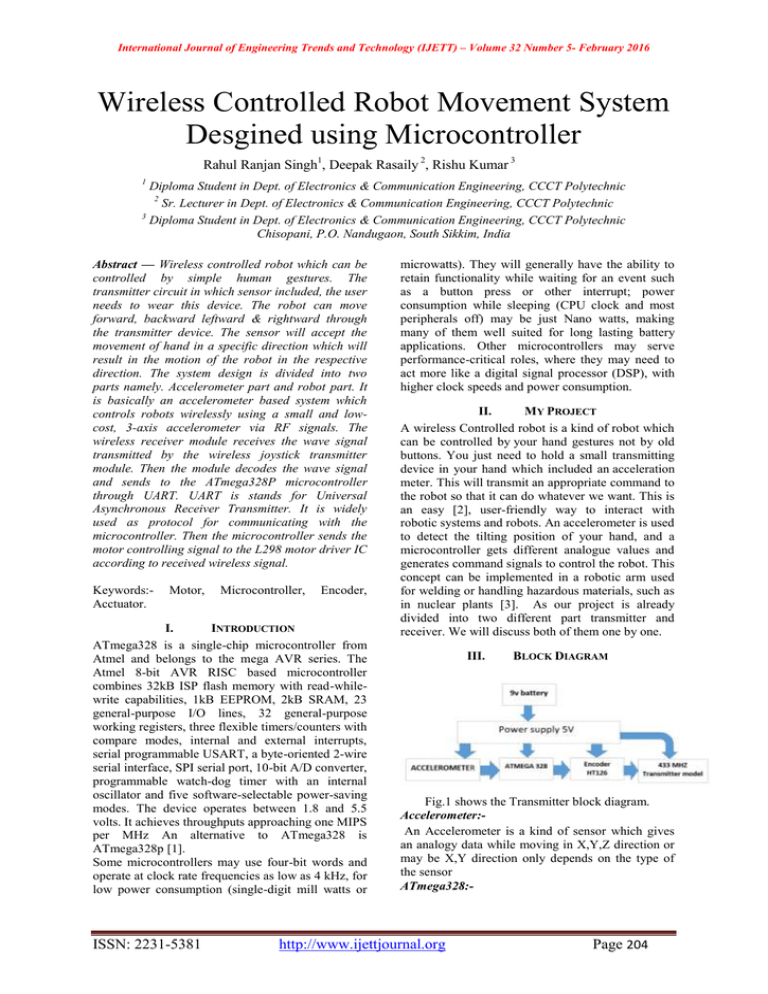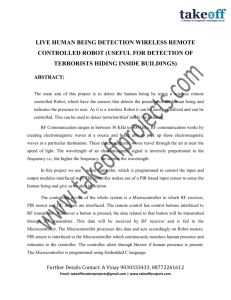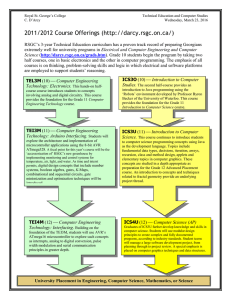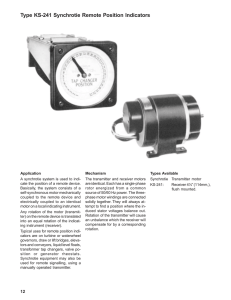Document 12917255
advertisement

International Journal of Engineering Trends and Technology (IJETT) – Volume 32 Number 5- February 2016 Wireless Controlled Robot Movement System Desgined using Microcontroller Rahul Ranjan Singh1, Deepak Rasaily 2, Rishu Kumar 3 1 Diploma Student in Dept. of Electronics & Communication Engineering, CCCT Polytechnic 2 Sr. Lecturer in Dept. of Electronics & Communication Engineering, CCCT Polytechnic 3 Diploma Student in Dept. of Electronics & Communication Engineering, CCCT Polytechnic Chisopani, P.O. Nandugaon, South Sikkim, India Abstract — Wireless controlled robot which can be controlled by simple human gestures. The transmitter circuit in which sensor included, the user needs to wear this device. The robot can move forward, backward leftward & rightward through the transmitter device. The sensor will accept the movement of hand in a specific direction which will result in the motion of the robot in the respective direction. The system design is divided into two parts namely. Accelerometer part and robot part. It is basically an accelerometer based system which controls robots wirelessly using a small and lowcost, 3-axis accelerometer via RF signals. The wireless receiver module receives the wave signal transmitted by the wireless joystick transmitter module. Then the module decodes the wave signal and sends to the ATmega328P microcontroller through UART. UART is stands for Universal Asynchronous Receiver Transmitter. It is widely used as protocol for communicating with the microcontroller. Then the microcontroller sends the motor controlling signal to the L298 motor driver IC according to received wireless signal. Keywords:Acctuator. Motor, Microcontroller, Encoder, I. INTRODUCTION ATmega328 is a single-chip microcontroller from Atmel and belongs to the mega AVR series. The Atmel 8-bit AVR RISC based microcontroller combines 32kB ISP flash memory with read-whilewrite capabilities, 1kB EEPROM, 2kB SRAM, 23 general-purpose I/O lines, 32 general-purpose working registers, three flexible timers/counters with compare modes, internal and external interrupts, serial programmable USART, a byte-oriented 2-wire serial interface, SPI serial port, 10-bit A/D converter, programmable watch-dog timer with an internal oscillator and five software-selectable power-saving modes. The device operates between 1.8 and 5.5 volts. It achieves throughputs approaching one MIPS per MHz An alternative to ATmega328 is ATmega328p [1]. Some microcontrollers may use four-bit words and operate at clock rate frequencies as low as 4 kHz, for low power consumption (single-digit mill watts or ISSN: 2231-5381 microwatts). They will generally have the ability to retain functionality while waiting for an event such as a button press or other interrupt; power consumption while sleeping (CPU clock and most peripherals off) may be just Nano watts, making many of them well suited for long lasting battery applications. Other microcontrollers may serve performance-critical roles, where they may need to act more like a digital signal processor (DSP), with higher clock speeds and power consumption. II. MY PROJECT A wireless Controlled robot is a kind of robot which can be controlled by your hand gestures not by old buttons. You just need to hold a small transmitting device in your hand which included an acceleration meter. This will transmit an appropriate command to the robot so that it can do whatever we want. This is an easy [2], user-friendly way to interact with robotic systems and robots. An accelerometer is used to detect the tilting position of your hand, and a microcontroller gets different analogue values and generates command signals to control the robot. This concept can be implemented in a robotic arm used for welding or handling hazardous materials, such as in nuclear plants [3]. As our project is already divided into two different part transmitter and receiver. We will discuss both of them one by one. III. BLOCK DIAGRAM Fig.1 shows the Transmitter block diagram. Accelerometer:An Accelerometer is a kind of sensor which gives an analogy data while moving in X,Y,Z direction or may be X,Y direction only depends on the type of the sensor ATmega328:- http://www.ijettjournal.org Page 204 International Journal of Engineering Trends and Technology (IJETT) – Volume 32 Number 5- February 2016 ATmega328 is a single-chip microcontroller from Atmel and belongs to the mega AVR series. The device operates between 1.8 and 5.5 volts [8]. It achieves throughputs approaching one MIPS per MHz An alternative to ATmega328 is ATmega328p. Encoder (HT12E IC):The HT12E is an 4bit encoder which encode the input data applied on it .The pin description of the HT12E is shown in the figure. RF Transmitter Module (TX):The transmitter module is working on the frequency of 433MHz and is easily available in the market at the cost of 250rs. Fig.1 shows the Transmitter Circuit diagram. The transmitter consists of ATmega328 microcontroller (IC2), ADXL335 accelerometer, HT12E encoder (IC4) and 433MHz RF transmitter module (TX1). In this circuit, two analogue outputs from ADXL335 pins (x, y) are connected with input pins (23, 24) of the microcontroller. Analogue signals are converted to digital signals through the microcontroller [4]. Digital outputs from pins 16, 17, 18 and 19 of the microcontroller are directly sent to pins 13, 12, 11 and 10 of encoder IC4. This data is encoded and transmitted via RF moduleTX1. Fig.1 shows the Receiver block diagram. RECEIVER RF Receiver Module (RX):The RF receiver module will receive the data which is transferred by the gesture device. It is also working as similar to the transmitter module. Decoder (HT12D):In a very simple way we can say that an HT12D converts that serial data into parallel which is received by the RF receiver module [7]. The pin description of the HT12D is shown in the figure. Motor driver IC (L293D):The Actuator's are those devices which actually gives the movement or to do a task like motor's. In the real world there are various types of motors available which works on different voltages [9]. So we need motor driver for running them through the controller. To get interface between motor and microcontroller. We use L293D motor driver IC in our circuit. IV. CIRCUIT AND PCB LAYOUT TRANSMITTER ISSN: 2231-5381 Fig.1 shows the Receiver Circuit diagram. The receiver part consists of 433MHz RF receiver module (RX1), HT12D decoder (IC5) and L293D motor driver (IC6) to run the motors. Here, receiver module RX1 receives the transmitted signal, which is decoded by decoder IC to get the same digital outputs [5]. Four outputs of IC6 drive two motors. The robot moves as per tilt direction of the accelerometer in the transmitter. The direction of the robot movement is as per logic listed in Table I. http://www.ijettjournal.org Page 205 International Journal of Engineering Trends and Technology (IJETT) – Volume 32 Number 5- February 2016 V. RESULT AND SIMULATION When switches A and D are on, motor rotates: - clockwise. When B and C are on, the motor rotates: Anti: -clockwise. When a and b are on, the motor will: - stop. Turning off all the switches gives the motor a free: - wheel drive. Turning on A & C at the same time or B & D at the Same time shorts the entire circuit. So, never try to do it. Simulation of project is performed on PROTEUS and the code was written Kiel software. Code for the microcontroller to run DC motors using the HBridge IC (L293D) is written. In the simulation the relevant data to the Microcontroller (ATMEGA328) is send through switches. The Microcontroller processed the data and sent the information to the Actuator IC (L293D). The Actuator IC upon receiving information showed response by driving the DC motors. Fig 9 Mount all components on the PCBs shown here to minimise assembly errors. Fix the receiver PCB and 4.5V battery on the chassis of the robot. Fix two motors, along with wheels, at the rear side of the robot and a castor wheel on the front. After uploading the main code into the microcontroller, remove it from the Arduino Uno board and insert it into the populated transmitter PCB. Now, switch-on the power supplies in the transmitter as well as receiver circuits. Attach the transmitter circuit to your hand and move your hand forwards, backwards and sideways [6][10]. Directions of the robot movement are given in Table I. The robot will stop if you keep your palm horizontal, parallel to the Earth’s surface. For troubleshooting, first verify that voltages at various test points are as per Table II. VI. CONCLUSION The purpose of project is to control a Robot using accelerometer sensors attached to a hand. The sensors are intended to replace the remote control that is generally used to run the Robot. It will allow us to control the forward and backward, and left and right movements, while using the same accelerometer sensor to control the throttle of the Robot. Future Scope The battery takes lot of space and also quit heavy. We can use the other power source in the place of batteries. We are using RF for wireless control, in RF the range in limited, nearly 50-80mm. we can solved this problem by using a GSM module. We can install camera on this circuit. For monitoring the robot from faraway places. Construction and Testing The transmitter section can be held in your palm or on the other side (refer Fig. 9). The receiver module is mounted on the robot. VII. REFERENCE [ 1] Waldherr, S., Thrun, S., and Romero, R., “A Gesture based interface for Human-Robot Interaction”, Kluwer Academic Publishers, Netherland, 2000 [ 2] Liu, T., Guo, H., and Wang, Y., “A new approach for colorbased object recognition with fusion of color models”, Congress on Image and Signal Processing Conference, Sanya-China, vol. 3, pp. 456-460, May 2008. ISSN: 2231-5381 http://www.ijettjournal.org Page 206 International Journal of Engineering Trends and Technology (IJETT) – Volume 32 Number 5- February 2016 [ 3] Wang, B., and Yuan, T., “Traffic Police Gesture Recognition using Accelerometer”, IEEE SENSORS Conference, Lecce-Italy,pp. 1080-1083, Oct. 2008. [ 4] Lalanne, T., and Lempereur, C., “Color recognition with a camera: a supervised algorithm for classification”, IEEE Southwest Symposium on Image Analysis and Interpretation, Tucson-Arizona, pp. 198- 204, April 1998. [ 5] R. Sharma, K. Kumar, and S. Viq, “DTMF Based Remote Control System,” IEEE International Conference ICIT 2006, pp. 2380-2383, December 2006. [ 6] R.C. Luo, T.M. Chen, and C.C. Yih, “Intelligent autonomous mobile robot control through the Internet,”IEEE International Symposium ISIE 2000, vol. 1, pp. 6-11, December 2000. [ 7] G. Arangurenss, L. Nozal, A. Blazquez, and J. Arias, "Remote control of sensors and actuators by GSM", IEEE 2002 28th Annual Conference of the Industrial Electronics Society IECON 02, vol. , 5-8 Nov. 2002,pp.2306 – 2310. [ 8] L. Schenker, "Pushbutton Calling with a Two- Group VoiceFrequency Code", The Bell System Technical Journal, 39(1), 1960, 235–255, ISSN 0005-8580. [ 9] P. Pradeep, M. Prabhakaran, B. Prakash, P. Arun Kumar, and G. Gopu, “Advanced Design for Robot in Mars Exploration,” presented at 2010 International Conference on Industrial Engineering and Operations Management Dhaka, Bangladesh, January 9 – 10, 2010. [ 10] T. Nguyen and L. G. Bushnell, “Feasibility Study of DTMF Communications for Robots,” Dept of EE, University of Washington Seattle WA, 98195-2500, April 6, 2004 [3] Rishu Kumar of final year student in the course of electronic and communication from CCCT Chisopani south Sikkim, India. His area of interest is in Microprocessor, Advanced Communication, Satellite and Cellular Communication, Microcontroller, PLC and Digital Electronics, Digital. Authors: [1] Rahul Ranjan Singh is a student doing his diploma in Electronics and Communication in Centre of Computers and Communications Technology, Chisopani, South Sikkim, India. His area of interest is in Fibre Optics, Data Communication, Mathematics, Power Electronics, Control System, Microcontroller and Microprocessor, Advanced Microcontroller, Advanced Communication and PLC [2] Deepak Rasaily is presently associated with the Department of Electronics and Communication Engineering at Centre for Computer and Communication Technology (CCCTGovt.Polytechnic) Chisopani, South Sikkim, India as a Senior Lecturer since 2003 to till date. He is MEScholar at National Institute of Technical Teachers’ Training & Research, Chandigarh, India. He Worked as Project Scientist in the Department of Science and Technology, Govt.of Sikkim prior to Lecturer in CCCT. His areas of interest are PLC and Robotics, Microprocessors and Microcontroller and Digital Signal Processing. ISSN: 2231-5381 http://www.ijettjournal.org Page 207




